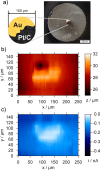Constant-distance mode SECM as a tool to visualize local electrocatalytic activity of oxygen reduction catalysts
- PMID: 24600538
- PMCID: PMC3943292
- DOI: 10.3762/bjnano.5.14
Constant-distance mode SECM as a tool to visualize local electrocatalytic activity of oxygen reduction catalysts
Abstract
Multidimensional shearforce-based constant-distance mode scanning electrochemical microscopy (4D SF/CD-SECM) was utilized for the investigation of the activity distribution of oxygen reduction catalysts. Carbon-supported Pt model catalyst powders have been immobilized in recessed microelectrodes and compared to a spot preparation technique. Microcavities serve as platform for the binder-free catalyst sample preparation exhibiting beneficial properties for constant-distance mode SECM imaging concerning modified surface area and catalyst loading. The integration of the redox competition mode of SECM into the detection scheme of the 4D SF/CD mode is demonstrated for specifically adapting high-resolution SECM experiments to powder-based catalyst preparations.
Keywords: SECM; electrocatalysis; oxygen reduction; recessed microelectrodes; redox-competition SECM; scanning electrochemical microscopy; shearforce-based constant-distance mode.
Figures






Similar articles
-
4D shearforce-based constant-distance mode scanning electrochemical microscopy.Anal Chem. 2010 Sep 15;82(18):7842-8. doi: 10.1021/ac1008805. Anal Chem. 2010. PMID: 20735144
-
Redox competition mode of scanning electrochemical microscopy (RC-SECM) for visualisation of local catalytic activity.Phys Chem Chem Phys. 2006 Dec 7;8(45):5359-65. doi: 10.1039/b609511a. Phys Chem Chem Phys. 2006. PMID: 19810414
-
Visualization of the local catalytic activity of electrodeposited Pt-Ag catalysts for oxygen reduction by means of SECM.Chemphyschem. 2009 Oct 19;10(15):2711-8. doi: 10.1002/cphc.200900496. Chemphyschem. 2009. PMID: 19784972
-
Scanning Electrochemical Microscopy as a Tool in Neuroscience.In: Michael AC, Borland LM, editors. Electrochemical Methods for Neuroscience. Boca Raton (FL): CRC Press/Taylor & Francis; 2007. Chapter 17. In: Michael AC, Borland LM, editors. Electrochemical Methods for Neuroscience. Boca Raton (FL): CRC Press/Taylor & Francis; 2007. Chapter 17. PMID: 21204395 Free Books & Documents. Review.
-
Emerging techniques and scenarios of scanning electrochemical microscopy for the characterization of electrocatalytic reactions.Chem Sci. 2025 May 13;16(22):9564-9576. doi: 10.1039/d5sc01854d. eCollection 2025 Jun 4. Chem Sci. 2025. PMID: 40406210 Free PMC article. Review.
Cited by
-
Electrocatalysis on the nm scale.Beilstein J Nanotechnol. 2015 Apr 21;6:1008-9. doi: 10.3762/bjnano.6.103. eCollection 2015. Beilstein J Nanotechnol. 2015. PMID: 25977871 Free PMC article. No abstract available.
-
Revealing How Alkali Cations Affect the Surface Reactivity of Stainless Steel in Alkaline Aqueous Environments.ACS Omega. 2018 Nov 1;3(11):14680-14688. doi: 10.1021/acsomega.8b02227. eCollection 2018 Nov 30. ACS Omega. 2018. PMID: 31458146 Free PMC article.
-
Operando Scanning Electrochemical Probe Microscopy during Electrocatalysis.Chem Rev. 2023 Apr 26;123(8):4972-5019. doi: 10.1021/acs.chemrev.2c00766. Epub 2023 Mar 27. Chem Rev. 2023. PMID: 36972701 Free PMC article. Review.
-
Probing the Local Reaction Environment During High Turnover Carbon Dioxide Reduction with Ag-Based Gas Diffusion Electrodes.Chemistry. 2021 Apr 1;27(19):5906-5912. doi: 10.1002/chem.202100387. Epub 2021 Mar 3. Chemistry. 2021. PMID: 33527522 Free PMC article.
References
-
- Bard A J, Fan F R F, Kwak J, Lev O. Anal Chem. 1989;61:132–138. doi: 10.1021/ac00177a011. - DOI
-
- Engstrom R C, Weber M, Wunder D J, Burgess R, Winquist S. Anal Chem. 1986;58:844–848. doi: 10.1021/ac00295a044. - DOI
-
- Wipf D O, Bard A J, Tallman D E. Anal Chem. 1993;65:1373–1377. doi: 10.1021/ac00058a013. - DOI
LinkOut - more resources
Full Text Sources
Other Literature Sources
